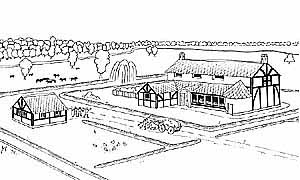 |
 |
|||
|
|
Berkshire History Roman Times Though Berkshire as a consolidated area still did not exist in the Roman period, the county made up the majority of the Civitas Atrebates. This Roman administrative unit, which also spread into North Hampshire, covered the Northern hinterland of the old capital of the Atrebates tribe at what we now call Silchester. The Romans knew the town as Calleva Atrebatum and it was here that they collected taxes and meated out justice to the local population. Silchester, of course, now stands just over the county boundary in Hampshire, but, in those days, it was the precursor of Berkshire's county-town of Reading, only eight miles away. Though some Iron Age people had lived in roughly organised oppida, their society was essentially rural and urban developments such as Calleva brought a completely new way of life to Britain: drains, streets, markets, shops, inns, temples, theatres and amphitheatres. The amphitheatre at Calleva no doubt held gory public entertainments, as at the Colloseum in Rome, but on a much smaller scale. Some think they were probably not much more than bull or bear baits, though somewhere in between is likely. This fascinating building actually stands in Mortimer West End which, until relatively recently was part of the tything of Stratfield Mortimer in Berkshire. As the major population centre in the area, Calleva became an important hub in an unprecedented communications network which emerged across Britain. Roads radiated out from here through Berkshire towards Dorchester-on-Thames, St. Albans (along the Camlet Way), London (along the Devil's Highway), Cirencester (along the Ermin(e) Way) and Bath, opening up the province like never before. The B4000 above Wickham still follows the old Roman Ermin(e) Way almost exactly, while stretches of the so-called Devil's Highway still exist (modernized of course) at Stratfield Mortimer, Beech Hill, Riseley, Finchampstead and across Swinley Forest at Crowthorne and Bracknell; stretches of the Dorchester road are probably identifiable at Brightwell, Cholsey and Moulsford.
The luxuries of civilization associated with town living also spread to the countryside: interior decoration, heating and washing facilities are aspects of Roman life that bring the Roman Villa immediately to mind. In fact, though many of Berkshire's villas, like those at Cox Green and Aldermaston, had colourfully painted walls, underfloor heating systems and steam bath suites, few have produced evidence of the height of Roman luxury: a patterned mosaic floor. Tiny fragments have been excavated in villas at Kintbury and near Eling, but only the Woolstone and Lower Basildon Villas have produced near complete survivals. The latter depicted an ornate geometric pattern, apparently worked by the finest of mosaicists from the so-called 'Central-Southern School' probably based in Winchester. Unfortunately, the Victorian workmen who discovered it destroyed this mosaic soon afterward.
Next: Dark Age & Anglo-Saxon Times By David Nash Ford
|
|||
| © Nash Ford Publishing 2001. All Rights Reserved. | ||||



 This
road system also linked Calleva to the various small towns more common
to the Berkshire landscape. These lesser settlements grew up as centres
of trade or other activities.
This
road system also linked Calleva to the various small towns more common
to the Berkshire landscape. These lesser settlements grew up as centres
of trade or other activities.  The
relative mediocrity of villas in Berkshire, betrays the real potential
which the Romans saw in the county. For the majority of these buildings
were not the country homes of the rich, but very much working
establishments at the centre of farm estates. Barton Court Farm (
The
relative mediocrity of villas in Berkshire, betrays the real potential
which the Romans saw in the county. For the majority of these buildings
were not the country homes of the rich, but very much working
establishments at the centre of farm estates. Barton Court Farm (